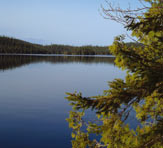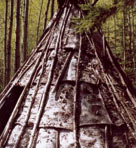  |
|
| |
Aboriginal Trapping and Hunting in relation to Sustainable Forest Management |
| |
|
| |
Ontario Trapping Harmonization Agreements (April-May 2006) |
| |
Trapping Harmonization Agreements were signed between Ontario and each of the three provincial/territorial organizations (PTOs) in the province. Click here for information about the agreement with the Grand Council Treaty Three. Information for the other two PTOs, the Union of Ontario Indians and the Nishnawbe Aski Nation, has not been located to date. |
| |
Alberta Interim Métis Harvesting Agreement (October 2004) |
| |
This agreement makes provisions for Métis people to hunt and fish without a license on Crown lands. On January 23, 2007, the Court of Queen's Bench ruled that this agreement is not legally enforceable. However, the decision also set aside the conviction of Métis man charged for trapping without a license, because it was deemed reasonable for the man to take the Agreement at face value as sanctioning the activity. Click here for a news release on this decision. |
| |
Cree Hunters and Trappers Income Security Board (Québec) |
| |
This is a legislated body in Québec that provides support for traditional livelihoods in the face of a changing landscape.
It offers a guaranteed income to heads of household who are involved in traditional harvesting activities more days than in wage labour employment (total 120 day minimum). The Board is made up of six people, three selected by the Quebec Government and the other three by the Cree Regional Authority. Studies indicate that as a result of the program there has been a renewal of subsistence activities in Cree bush communities. |
| |
The Trapping Rights of Aboriginal Peoples in Canada (Monique M. Passelac-Ross 2005) |
| |
This paper investigates the legal nature of the trapping rights of treaty beneficiaries in Alberta, with a focus on Treaty 8, signed in 1899. It examines different interpretations of the right adopted by the courts, by Aboriginal peoples, by government and by various experts and documents the erosion of the right resulting from government regulation and resource development. Finally, it suggests a more generous interpretation of the trapping right as a right to sustain a moderate livelihood. |
| |
Collars to Help Track Moose Decline (Waswanipi Cree Model Forest 2004)
|
| |
Waswanipi Cree hunters participate in a project to track moose over multiple years, in an effort to describe their response to habitat fragmentation due to a variety of disturbances, including timber harvest. |
| |
Fur Institute of Canada website |
| |
The Fur Institute has an Aboriginal Communications Committee, and 5 of its 24 Directors are Aboriginal. "The Institute is an umbrella organization for the fur industry across Canada. We are committed to delivering information to the media, the general public and governments pertaining to the economic, social, cultural and environmental issues surrounding today’s fur trade." (from website) |
| |
Sustainable Forest Management for Timber, Furbearers and Forest Biodiversity: A Guide for Trappers, Furbearer and Forest Managers (Fur Institute of Canada 2006) |
| |
This report is also available in French. |
| |
Aboriginal Trapping Working Group (National Forest Strategy Theme 3) |
| |
Cree-Québec Forestry Board |
| |
As a joint management institution with equal number of Cree and provincial seats, the Cree-Québec Forestry Board is currently testing methods for involvement of Cree
trappers in advance of forest planning. Participants in this project include representatives of
the Forest and Wildlife sections of the provincial Department of Natural Resources and
Wildlife, Cree trappers, the Waswanipi Model Forest, and forest companies. Through local
Joint Working Groups, the Cree tallymen participate directly in designating special management
areas and conditions. In early 2006, the Board submitted advice to the Québec Minister of Wildlife and Natural Resources, based on the findings of a pilot project to protect wildlife habitat. |
| |
|
| |
|
| |
|
| |
|
| |
|
| |
|
| |
|
| |
|
| |
|
| |
|


